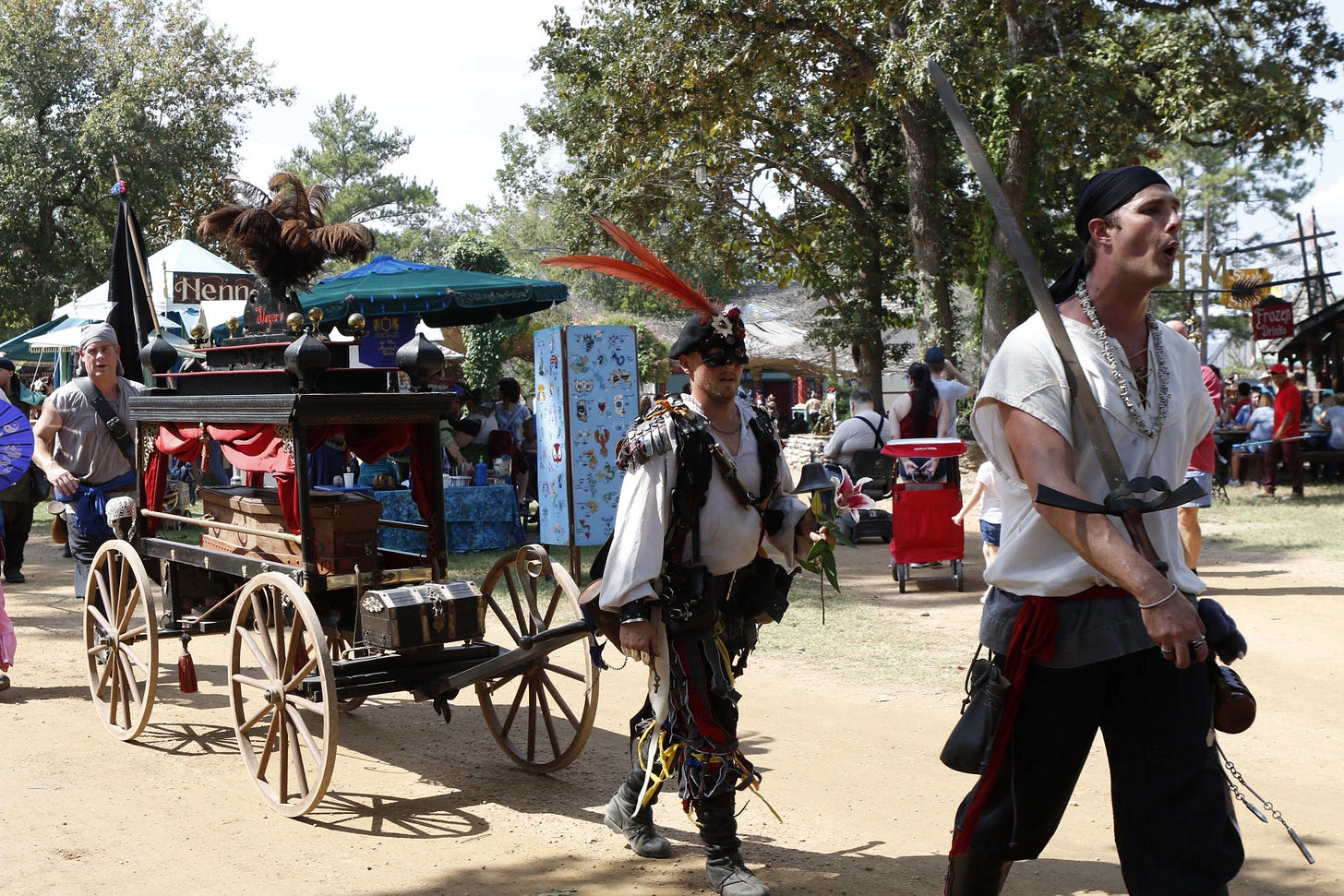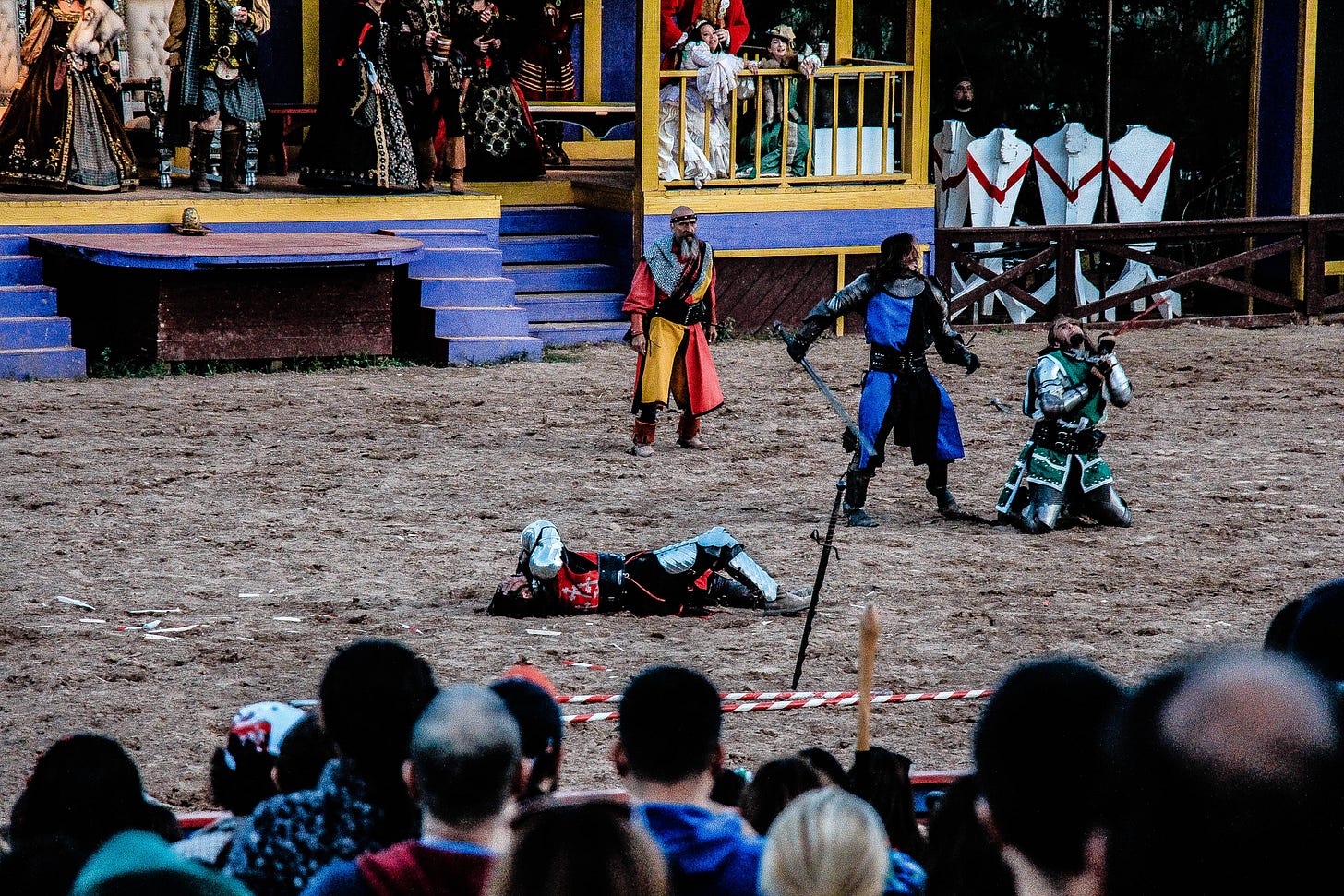Renaissance, Texas: Fantasy and Murder at the World's Biggest RenFaire [4]
"Live blow-up dolls" and tankards of ale. At the Texas Renaissance Festival, the Lone Star locals learned to let loose.
“Renaissance, Texas” is a nine-part, serialized story I’m running exclusively in my newsletter. To read from the beginning with Post 1, click here.
Back in 2004, as Brandon Smith and his family made their way through the bustling gates of the Texas Renaissance Festival late on that October morning, they had reason to want a little fantasy in their lives. Smith’s father had died of a heart attack when he was just six; one of his brothers drowned in a swimming pool in 1980; another brother had died the year before in a four-wheeler accident. So, with just a few days of Brandon’s leave from the Navy to be together, he and his younger sister Kristen were eager to enjoy some puppet shows and turkey legs.
But Smith apparently couldn’t leave his sense of duty far behind. When Brent Noland, a wiry, 19-year-old with short dark hair approached them for help, Smith was happy to oblige. Noland told them he’d come to the Fest with a group of buddies from his nearby hometown of Montgomery, but gotten separated from the group. He asked if he could borrow a cell phone call them, because he didn’t have one on him.
Noland had already been partying despite the early morning hours – smoking some weed, washing down a couple Xanax with a beer. Sensing the younger man could use some direction in life, Smith began extolling the virtues of the Navy, and jotted down his name and number should Noland ever want to pursue it. "He was a 24-hour-a-day recruiter," Smith’s friend Betsy Barricklow later told the Houston Chronicle, "This was a young man who, I think, was going to be in the military until retirement."
After Noland and the siblings parted ways, Brandon and Kristen made their way across the grounds, where 3,000 colorfully-costumed characters were there to mingle, jabbering in broken Old English and performing period festivities on 21 scattered stages.
There were mud fights, wandering lute-strumming minstrels, teams of jugglers, and goofy comedians like the “PeeBodies,” two men who dressed as though they were soaked in urine. Self-described “beer wenches,” who’d deliver tankards of ale.
Coulam promoted a free-loving atmosphere — and with all the drinking and dancing and leather clothing, things tended to get debauched easily. “Every girl has a little naughty in them,” Melba Tucker, the TRF’s marketing director, told me in 2004. “This is a chance for them to let it out.”
For a small fee, patrons could use their teeth to pull a variety of shrewdly-placed knickknacks from a given beer wench’s cleavage. “I put a plastic straw in mine,” said Melba’s 19-year-old daughter Blair. “I tell the guys I’m a live blow-up doll.”
While Coulam’s fantasy world is a vacation for most visitors like the Smiths, it’s everyday life for the several hundred Rennies who joined King George to make Todd Mission their home. For the past 20 years, they live year-round in a makeshift village that Coulam provides for them, selling each of them one-acre plots for ridiculously cheap prices so they could create their own inspired homesteads.
During my visit, one was in the shape of a giant brown pirate ship with masts and portholes; another looked like a tree house from the Hobbit shire. Laurie Watson, an earnest, 48-year-old fortune teller with wide eyes and long dark hair, operated out of a day-glow orange shack in a lot with a wooden sign that read, “The Sun and Moon Hideaway.” Headless mannequins draped in Mardi Gras beads lined the fence. As we spoke, a chubby, bearded man wandered around her yard blissfully, twirling three, small crystal balls in his hands.
“This is a way to keep the last taste of gypsy magic,” Watson told me. “I love George. If we didn’t have this, we’d have nothing. George has an appreciation of art, he’s a naturalist, he’s kind … ” She choked up while explaining, and a tear ran down her cheek.
“We weren’t meant to work in air-conditioned cubicles,” she went on, “We were meant to make love! We were meant to be free!”
“George has a real vision,” agreed Mark “Coop” Cooper, a 56-year-old who told me he had given up his seat on the Chicago Mercantile Exchange to follow King George down here. “We’re all riding on George’s dream,” he said.
The dream was to live and work as free-spirited artists.
Cooper and the others called the neighborhood Toontown, after the fictional cartoon neighborhood in Los Angeles from the 1988 film “Who Framed Roger Rabbit.” “We’re the crazies living on the other side of the railroad tracks,” he joked.
Charles Prince, the one-time head of the Houston Chef’s Association who in 2004 was running the largest restaurant at the festival, The King’s Feasting Hall, agreed. “George has been king of the hippies for a long time now,” he said.
In the next post of “Renaissance, Texas:” King of the Hippies.






